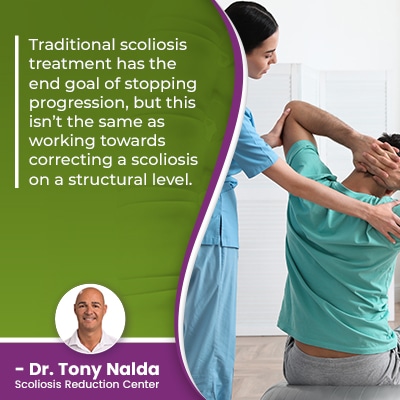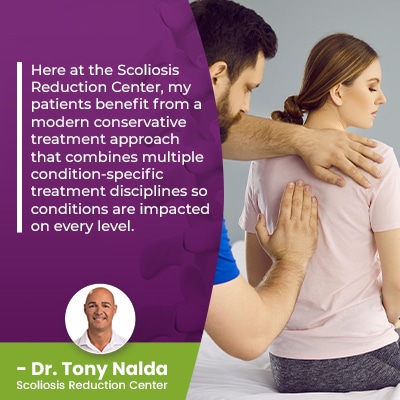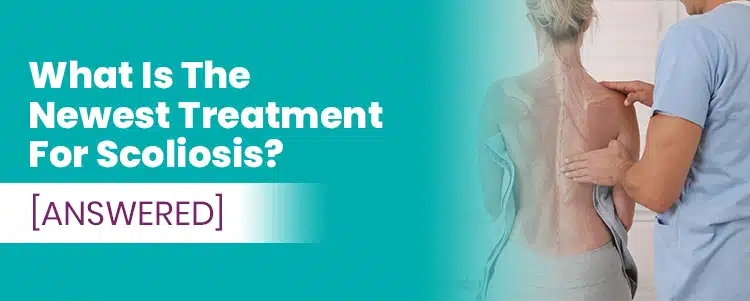When someone is diagnosed with scoliosis, they have a lot of questions and concerns, from what caused the condition to develop to how bad it can get. What’s most important is how a diagnosis is responded to in terms of treatment; as a progressive condition, scoliosis is incurable, but it can be highly treatable.
There are two main scoliosis treatment approaches for patients to choose between; traditional scoliosis treatment was the dominant choice for many years, and newer conservative scoliosis treatment offers a non-surgical treatment alternative.
Before getting to the specifics of different treatment options for scoliosis, let’s explore the parameters that have to be met to reach a diagnosis of scoliosis.
Diagnosing Scoliosis
Diagnosing scoliosis isn’t always easy; particularly in mild forms with subtle symptoms, early detection can be a challenge.
While there are never treatment guarantees, diagnosing scoliosis early means the opportunity to start treating scoliosis early in its progressive line, and the benefits to that can be preventing progression, increasing condition severity and effects.
Diagnosing scoliosis means an unnatural sideways spinal curve, that also twists (rotational component) and has a minimum Cobb angle of 10 degrees, has developed.
A patient’s Cobb angle is known as the gold standard in the diagnosis and assessment of scoliosis, and it’s determined during X-ray by drawing lines from the tops and bottoms of the curve’s most-tilted vertebrae; the resulting angle is expressed in degrees.
The highers a patient’s Cobb angle, the further out of alignment their spine is, and the more severe their condition:
- Mild scoliosis: Cobb angle measurement of between 10 and 25 degrees
- Moderate scoliosis: Cobb angle measurement of between 25 and 40 degrees
- Severe scoliosis: Cobb angle measurement of 40+ degrees
- Very-severe scoliosis: Cobb angle measurement of 80+ degrees
As a progressive condition, where a scoliosis is at the time of diagnosis doesn’t mean that’s where it will stay; only proactive treatment can work towards counteracting the condition’s progressive nature.
In most cases, the more severe a condition, the more noticeable its effects are going to be; in children, the main effect is postural deviation, and in adults, it’s pain.
Scoliosis doesn’t become a compressive condition until skeletal maturity has been reached, and it’s compression of the spine and its surrounding muscles and nerves that causes the majority of scoliosis-related pain.
In children, the condition’s earliest signs are often uneven shoulders and hips, and as scoliosis progresses, postural changes become more overt and can include the development of a rib arch, an uneven waistline, and arms and legs that appear to hang at different lengths.
In addition, as the condition disrupts the body’s center of gravity, changes to gait, balance, and coordination are also common.
Now that we’ve explored the basics of how scoliosis is diagnosed, let’s now take a look at how each of the two main scoliosis treatment approaches addresses the condition’s progressive nature.
Scoliosis Treatment: Traditional vs Modern
As mentioned, there are two main scoliosis treatment approaches: traditional and conservative.
Scoliosis has been around since ancient times, and traditional scoliosis treatment was the dominant treatment choice for many years, but that doesn’t mean it was the best, nor only treatment option available.
Traditional scoliosis treatment has a different goal than modern conservative treatment, and this is evident in how they approach progression.
Scoliosis is a progressive condition, meaning its nature is to get worse over time; one treatment approach works towards stopping progression, while the other works towards corrective results.
Stopping a condition from getting worse isn’t the same as working towards correcting it, and when it comes to the main difference between traditional and modern scoliosis treatment, we’re talking about their different end goals.
Traditional Scoliosis Treatment

Traditional scoliosis treatment has the end goal of stopping progression, but this isn’t the same as working towards correcting a scoliosis on a structural level.
Traditional scoliosis treatment responds to a diagnosis of scoliosis in a reactive way; it doesn’t start treatment immediately, but rather waits for when/if a patient’s scoliosis becomes severe enough to make them surgical candidates.
In that way, traditional treatment funnels patients towards invasive spinal fusion surgery because it doesn’t have a strategy for treating scoliosis while mild.
Traditional scoliosis treatment uses bracing for moderate scoliosis, which is associated with a number of shortfalls, and other than that, recommends spinal fusion when/if scoliosis progresses into the severe classification at 40+ degrees.
While spinal surgeons have their patients’ best interests at heart, spinal surgery is invasive, costly, and risky, and spinal fusion carries some heavy potential risks, side effects, and complications I want patients to be aware of.
Spinal fusion involves fusing the curve’s most-tilted vertebrae into one solid bone to eliminate movement (progression) in the area, and this commonly involves the removal of intervertebral discs in between the vertebrae fused, and attaching rods to the spine to hold it in place.
Fusing the spine is contrary to its movement-based design, and this can cost the spine in terms of its long-term spinal strength, health, and function.
A reduced range of motion and spinal flexibility is common, and this can disrupt quality of life for some patients, while others can maintain enough flexibility above and below the fused portion to maintain a decent range of motion.
While each patient will respond to spinal fusion in their own way, there are some serious risks that should be considered carefully, and risks associated with the procedure itself can include:
- Infection
- Nerve damage
- Adverse reaction to hardware used
- Excessive blood loss
And the reality is that many cases of scoliosis don’t require surgical intervention, and this is where modern conservative scoliosis treatment comes in.
Conservative Scoliosis Treatment
Here at the Scoliosis Reduction Center®, my patients benefit from a modern conservative treatment approach that combines multiple condition-specific treatment disciplines so conditions are impacted on every level.

Chiropractic care helps impact the condition’s underlying structural nature by working towards manually adjusting the position of the curve’s most-tilted vertebrae back into alignment with the rest of the spine.
Physical therapy and scoliosis-specific exercises (SSEs) can help increase the spine’s surrounding muscle strength so they can optimally support it, improve posture, and activate specific areas of the brain for improved brain-body communication.
When it comes to modern bracing, this is corrective bracing, and this complements the goal of modern conservative treatment: achieving corrective treatment results.
I opt for the modern ScoliBrace which represents the culmination of what we’ve learned about scoliosis and bracing efficacy over the years, and the ScoliBrace addresses many of the shortcomings associated with traditional bracing.
Rehabilitation can involve lifestyle guidance, continued chiropractic care, and the prescription of custom-prescribed home exercises to further stabilize and heal the spine.
While there is still a place for the surgical treatment of scoliosis, modern conservative treatment results prove that many cases of scoliosis can be addressed successfully with less-invasive forms of non-surgical treatment.
Also known as chiropractic-centered and/or functional treatment, conservative scoliosis treatment has the goal of treating scoliosis while preserving as much of the spine’s natural strength and function as possible, throughout treatment and beyond.
Conclusion
The newest treatment for scoliosis is modern conservative chiropractic-centered treatment.
In ancient times, scoliosis treatment included tying patients to wooden poles and sticks in an attempt to straighten the spine, and this is the precursor for spinal fusion surgery that involves attaching rods to the spine with pedicle screws to maintain its aligned position.
While there is still much we don’t know about the condition, we have learned a lot about scoliosis and how it responds to treatment over the years, and we have since learned that many cases of scoliosis can be treated with non-surgical treatment.
There are never treatment guarantees, but particularly with early detection, there are fewer limits to what can be achieved; scoliosis that’s diagnosed earlier means treatment can be started earlier, and as scoliosis only gets more complex to treat the more it progresses, this can be highly beneficial.
When it comes to proactive conditions like scoliosis, it can be far more effective to proactively work towards preventing the condition from progressing, rather than attempting to reverse its effects once they’re established.
As the Scoliosis Research Society has current estimates at close to seven million people currently living with scoliosis in the United States alone and it’s the most-common spinal condition amongst school-aged children, the condition warrants awareness.
Patients wanting to forgo a surgical recommendation, or who simply want to try a less-invasive treatment option first, can turn to modern conservative treatment for a fresh approach to addressing a highly-prevalent ancient spinal condition.




